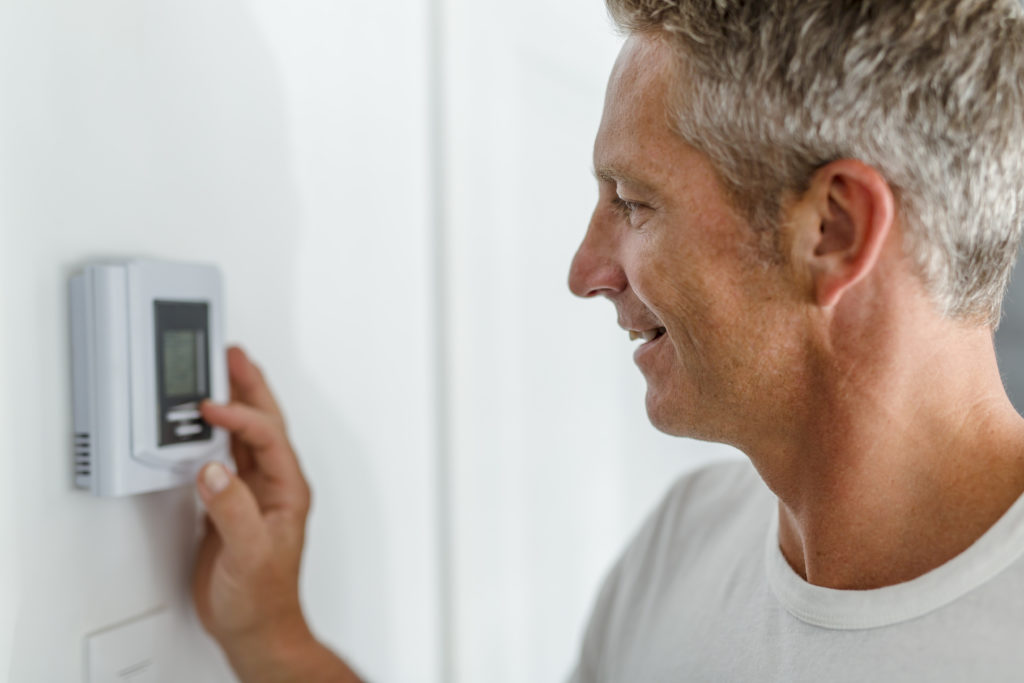Holiday Home Safety Tips
Posted on by WestAIR Heating & Cooling
 The holidays are exciting, filled with gift shopping, decorating, cooking, hosting the extended family, or traveling to a Christmas getaway. But don’t overlook small details that are mishaps waiting to happen. From the ten-year-old string of decorative lights wrapped around your banister to the poisonous poinsettia plant sitting on your dining room table, the festivities bring many hazards to your home. Have an enjoyable and accident-free Christmas season with these holiday home safety tips:
The holidays are exciting, filled with gift shopping, decorating, cooking, hosting the extended family, or traveling to a Christmas getaway. But don’t overlook small details that are mishaps waiting to happen. From the ten-year-old string of decorative lights wrapped around your banister to the poisonous poinsettia plant sitting on your dining room table, the festivities bring many hazards to your home. Have an enjoyable and accident-free Christmas season with these holiday home safety tips:
Electrical threats
Before you hang up electric decorations, inspect them for damage. Look for cracked sockets, loose connections, or frayed cords. An exposed wire could light up your Christmas tree in flames. Never overload outlets or connect more than three strings of electrical lights. They could trip a breaker or start a fire.
Fire
You should always check your fireplace and chimney before you light it. Santa may not be peeking down at you from the roof, but there could be debris blocking smoke and creating a fire hazard. If you have a real Christmas tree, water it daily, and don’t put it too close to the fireplace. Keep combustibles at least three feet from heat sources and never block exits in case of a fire.
Decorating danger
In a quest to outdo last year’s Christmas décor, many homeowners take decorating to new heights, quite literally. If you plan to hang sparkling ornaments or lights in high places, don’t climb or stand on furniture. Use a proper ladder and have someone support the base if you need to hang decorations beyond your normal reach.
Theft
Try not to order anything online to be shipped to your home if you plan to be away for the holidays. Thieves can easily run up and snatch retail packages on a porch. Don’t leave large displays of holiday gifts near windows where passersby can easily see them. If possible, ask a neighbor to keep an eye on your home while you are away so you don’t have to worry about holiday theft.
Cold weather
If you plan to be away for the holidays, take steps to prevent frozen pipes. Basement, attic, and garage pipes are most susceptible to freezing and bursting in cold temps, causing significant water damage in a matter of hours. Make sure to close your garage door when you leave to keep the cold air out. Open kitchen and cabinet doors so the warmer air throughout your home will circulate and reach the pipes in your walls. Set the thermostat to a temperature no lower than 55 degrees.
WestAIR Heating & Cooling offers programmable thermostats with vacation-hold settings so you can easily stay in control of your heat while you are away. We can install a gas fireplace so you don’t have to worry about the decorations, Christmas tree, or wrapping paper falling into the hearth and catching fire. Contact us to learn more about your heating options this holiday season.
This entry was posted in Winter and tagged Garage, Heating, Holidays, HVAC, Thermostat, Winter
Are Radiant Infloor Heating Systems Worth the Cost?
Posted on by WestAIR Heating & Cooling
Have you ever been to a home or building with heated floors? Even on a chilly winter evening, your feet feel warm. The air around you feels comfortable, not drafty. Some homeowners find heated floors a necessity, while others think they’re an expensive and frivolous feature. Let’s consider the pros and cons of radiant infloor heating.
Advantages
Energy Efficiency
Traditional boiler and forced air systems heat the nearest area of space. The radiator can have an internal temperature between 159-167 degrees Fahrenheit just to heat up a room. By the time the warm air makes its way to the other side of the room, the air cools below the programmed temperature. Depending on the location and size of the room, a radiator or forced air can create inconsistent temperatures.
Infloor heating covers the entire floor. Heat rises, so no matter where you walk, the room will reflect the correct temperature. Furthermore, the source typically heats up between 80 – 90 degrees. Best of all, radiant heat can save 15 to 40 percent on energy bills because of its efficient technology.
Minimal Maintenance
Did you know you should have your furnace checked once a year, as well as change your air filter multiple times a year? Service visits costs add up, especially if your heating system needs replacement parts. There are no maintenance costs with radiant infloor heating, and some brands guarantee their product for decades!
Space
Boiler systems and forced air take up space. Boiler radiators reduce physical space in a room and can create challenges with furniture placement. Forced air systems make use of ceiling, wall, and floor space for ducts and vents. With infloor heating, the flooring conceals all equipment, allowing for an open, spacious feel.
Comfort
We all have experienced the shocking feeling of bare feet on a cold floor during the winter. With radiant infloor heating, your feet will feel cozy all winter long, even without socks.
Versatility
Infloor heating works with all floor types: wood, stone, tile, carpet, laminate, and more.
Safety
Radiators can pose safety hazards and cause injuries such as burns and cuts. In addition, forced air reduces oxygen and the thermal circulation kicks up dust, which can aggravate allergies, asthma, and other respiratory conditions. Radiant heat keeps air fresh and oxygen-rich and dust out of the air.
Disadvantages
Electric heating installation costs $10 to $20 per square foot. Connecting the system to your power supply adds an extra few hundred dollars to the bill. Another disadvantage—the process takes one to two days to dry, because of leveling compound that tops the thermal mat. Water-based systems cost more than double that of electric heating and require installation during the build phase of a new home. Lastly, radiant infloor heating adds about half an inch to the floor. Experts recommend using insulation boards underneath, increasing height by approximately an inch more.
Many homeowners say that the advantages of infloor heating outweigh the disadvantages, and the cost of installation is ultimately worth it. You don’t need to build a new home to try radiant infloor heating. If it’s time to remodel your bathroom or basement, look into infloor heating for added comfort, improved energy efficiency, and increased resale value.
Contact WestAIR Heating & Cooling to learn more about installing radiant infloor heating.
This entry was posted in Heating,Winter and tagged Floor heating, Radiant heating, Radiant infloor heating
Extend the Life of your HVAC Equipment
Posted on by WestAIR Heating & Cooling
Having a working furnace and air conditioner is crucial during the winter and steamy summer days. Don’t run it and forget about it, as wear and tear is inevitable. You can save on costly replacements or repairs through proper maintenance. Extend the life of your HVAC equipment by following these steps.
Heating & Cooling Tips
1. Follow manufacturer instructions.
2. Have your systems checked every year by a qualified service technician. It’s best to schedule maintenance in the spring and fall. Technicians are busy in the hot and cold months, and you don’t want to wait until there’s something wrong.
3. Check your filters. Replace your filters every 30 to 60 days. If you have a permanent filter, clean it with mild detergent every 30 to 60 days. This is the most important step to increase the life of your equipment. Dirty filters make heating and cooling units work harder, which will shorten the life with use.
4. Keep your doors and windows closed. Your air conditioner and heater will work harder when there is more air to circulate. Make each space with ventilation smaller by closing your doors. This is the also the case for houses with boilers or window air conditioners. Rather than labor to regulate air temperature in the whole house, your a/c only needs to cool the individual room. With a boiler system, it’s efficient to close off rooms without a radiator.
5. Caulk and weather-strip air gaps on windows. This step is good for your wallet and your HVAC equipment. Old houses are especially drafty, so locate the air leaks by finding damaged glazing or old caulking. Another trick is to turn off all appliances and light an incense stick in each room. Turn on your exhaust vent if you have one. Then hold your incense stick close to windows, doors, and walls for a noticeable change in the smoke. If you have drafty doors, invest in some door draft blockers.
6. Use your thermostat. It’s a myth that you should keep your thermostat at a steady temperature. Most of the time, your furnace will be working harder to maintain the heat at a steady rate. Instead, program your thermostat for a comfortable temperature while you are home and ten degrees less while you are away. However, fidgeting with the thermostat will be less efficient, even if it seems harmless to put it up or down a degree or two. Keep it on a consistent schedule.
Energy Efficiency
Winter
1. Open window shades when windows are facing the sun. Let the sun warm your house naturally, putting less work on your furnace. The vitamin D is good for you this time of year!
2. Take advantage of using your oven. Slow cook your chicken and oven roast your veggies. The extra warmth will give your furnace a break. Your oven will be working two jobs at once without the added cost.
Summer
1. Close window shades facing the sun. Opposite of wintertime, you want to block the sun from adding extra heat to your house. Make sure to put your plants outside so they don’t suffer from the lack of sun!
2. Be smart with your other appliances. When you are doing laundry, hang up your clothes on a line to save energy or strain on your a/c. Why work an appliance that uses heat when it’s already hot outdoors? Washing clothing shouldn’t be an issue, though, if you stick to cold water. If it’s humid out, dry your clothes during the coolest part of the day: around dawn. Same goes for dishwashers.
3. Use your exhaust fans when cooking. Whether you plan on using the oven or stovetop for dinner, turn on the exhaust fan to let out the excess moisture and heat. Or maybe fix a cold sandwich or salad. In return, your air conditioner won’t have to work as hard! Same goes for your bathroom, but not everyone likes cold showers!
Annual Service Maintenance
Spring is around the corner, so it’s time to schedule your maintenance visit with WestAir Heating & Cooling.
Our technician’s maintenance list will take care of most things you cannot do yourself to ensure your equipment is running smoothly for summer and winter:
Annual Service Maintenance list:
• Clean furnace and check operation/filter
• Clean air conditioner and check operation
• Clean outdoor condenser and check refrigerant level
• Clean air exchanger filters and core
• Check radiant in-floor pressures and go over system
• Check humidifier filter and drain line
• Check unit heater operation
• Clean fireplace and check operation
Contact us for more information on heating, cooling, or our service maintenance!
This entry was posted in AC,Air Conditioning,Cooling,Furnace,Heating,Winter and tagged A/C, A/C, Air conditioner, Air filters, Air quality, Annual check-up, Caulk, Clogged filter, Cold air, Cooking, Cooling, Cost, Dirty, Dishwasher, Door draft stopper, Doors, Drafty windows, Dryer, Efficiency, Energy efficient, Exhaust fan, Fall, Filter, Filters, Furnace, Furnace filter, Heater, Heating, HVAC, Laundry, Maintenance, Quality, Save money, Shower, Spring, Summer, Sunshine, Sustainability, Thermostat, Windows, Winter
Why You Need a Whole-Home Humidifier
Posted on by WestAIR Heating & Cooling

Did you know that the most comfortable indoor air humidity level is 40 to 60 percent? Cold air does not hold water vapor well, making it drier as it gets colder. Dry air could be the reason you get nose, throat, and skin discomfort in the winter.
What makes it worse?
Turning on your heat.
Heated air with low humidity also dries out the wood in your home, shrinking the wood framing around doors and windows. The shrinking causes gaps to occur and allows cold air in. Any moisture will drain outdoors, leaving you with cracked and dry skin.
Unfortunately, you can over-humidify your house as well. Too much humidity in the winter can damage windows as ice forms. If this happens, moisture will most likely be present in walls and attics, causing sheathing and woodwork to rot over time. This not only damages your house, but the mold can make you sick.
What do you do then?
The solution needs to keep your home’s humidity at a happy medium. The percentage of optimum humidity changes as it gets colder.
Outside Temperature |
Max Humidity |
| 20 – 40 | 40% |
| 10 – 20 | 35% |
| 0 – 10 | 30% |
| -10 – 0 | 25% |
| -20 – -10 | 20% |
| Below -20 | 15% |
*Based on an indoor temperature of 70 degrees F
You can improve your humidity levels and your heating bills by caulking and sealing your windows and doors. Next, you can maintain indoor humidity levels with a home humidifier. When your home’s humidity falls below the optimum level, a whole-home humidifier from Aprilaire goes to work, adding moisture to your dry air. This dry air is forced through the water panel evaporator and is distributed throughout your home, eliminating that parched, dry air lurking in your home. Aiprilaire offers humidifiers that are energy efficient, reduce airborne viruses, and protect wood floors or furniture.
Eliminate the damage and discomfort caused by dry air. We’re currently offering $25 off the installation of an Aprilaire Whole-house Humidifier. Offer ends December 31st. Call us today!
This entry was posted in Humidifier,Winter and tagged Air, Airprilaire, Cold, Doors, Dry, Dry skin, Heater, Home humidifier, Humid, Humidity, Windows, Winter
Find the Right Garage Heater
Posted on by WestAIR Heating & Cooling
November is finally pushing us to turn on our thermostats. If you have any last-minute home or work projects to finish, you will need a garage heater as well. If this is your first heater, you will need to assess this situation first. Ask yourself, what do you need a heater for?
Heaters for quick projects.
Are you doing some quick fixer-uppers such as fixing or replacing parts from time to time? Do you have a designated workspace in your garage? If so, consider getting a portable electric heater. These garage heaters are lightweight, quiet, and provides direct heat.
Heaters on the go.
Do you need your garage heater for work projects outdoors or for a traveling job? You will want something fast and portable. Portable gas and kerosene heaters are lightweight and need little maintenance. Both use a fan to help circulate air.
Heaters for long-term projects.
Do you spend most of your time in the garage? Fixing up cars or hanging out with your buds, or just finished the great “Man Cave”? You will want a heater that is installed and thermostat controlled. Installed gas heaters are quick, quiet and project more heat. Electric installed heaters are compact and need little maintenance. Both types of heaters require mounting or installation. We recommend this option because you can keep your space warm to avoid letting your car idle in the winter. You can also provide a warm area for your family or pets.
Schedule an appointment today if you are interested in installing a unit heater for your garage.
This entry was posted in Fall,Furnace,Garage,Heating,Winter and tagged Cold weather, Electric heater, Fall, Furnace, Garage heater, Garage heaters, Gas heater, Heaters, Kerosene, Thermostat, Unit heater, WestAIR, Winter
Subscribe to Our Blog
With RSS feeds, you don't have to visit our site everyday to keep up to date. Simply subscribe to our blog via RSS or Email and our posts will come to you!
Search Blog Posts
Categories
Archives
- April 2024 (1)
- February 2024 (1)
- January 2024 (1)
- February 2023 (1)
- January 2023 (1)
- December 2022 (1)
- November 2022 (1)
- October 2022 (1)
- September 2022 (1)
- August 2022 (1)
- July 2022 (1)
- June 2022 (1)
- May 2022 (1)
- April 2022 (1)
- March 2022 (1)
- February 2022 (2)
- December 2021 (1)
- November 2021 (1)
- October 2021 (1)
- September 2021 (1)
- August 2021 (1)
- July 2021 (1)
- June 2021 (1)
- May 2021 (1)
- April 2021 (1)
- March 2021 (2)
- January 2021 (1)
- December 2020 (1)
- November 2020 (1)
- October 2020 (1)
- September 2020 (1)
- August 2020 (1)
- July 2020 (1)
- June 2020 (1)
- May 2020 (1)
- April 2020 (1)
- March 2020 (1)
- February 2020 (2)
- November 2019 (1)
- August 2019 (2)
- June 2019 (1)
- May 2019 (1)
- April 2019 (1)
- March 2019 (1)
- February 2019 (1)
- January 2019 (1)
- December 2018 (1)
- November 2018 (1)
- October 2018 (1)
- September 2018 (1)
- August 2018 (2)
- July 2018 (1)
- May 2018 (1)
- April 2018 (1)
- March 2018 (1)
- February 2018 (1)
- January 2018 (1)
- December 2017 (3)
- November 2017 (2)
- October 2017 (2)
- September 2017 (2)
- August 2017 (1)
- July 2017 (2)
- June 2017 (3)
- May 2017 (2)
- January 2017 (4)
- November 2016 (1)
- September 2016 (3)
- July 2016 (2)
- June 2016 (2)
- May 2016 (4)
- April 2016 (1)
- March 2016 (2)
- February 2016 (2)
- January 2016 (1)
- August 2015 (1)
- July 2015 (1)
- June 2015 (3)
- May 2015 (1)
- July 2014 (2)
- June 2014 (1)
- April 2014 (1)
- March 2014 (1)
- February 2014 (2)
- October 2013 (1)
- May 2013 (1)
- March 2013 (1)
- February 2013 (1)
- August 2012 (1)
- July 2012 (2)
- June 2012 (2)
- May 2012 (2)
- March 2012 (1)
- February 2012 (1)
- December 2011 (1)
- November 2011 (1)
- October 2011 (1)
- September 2011 (1)
- August 2011 (1)
- June 2011 (1)
- May 2011 (1)



 Subscribe
Subscribe Subscribe
Subscribe